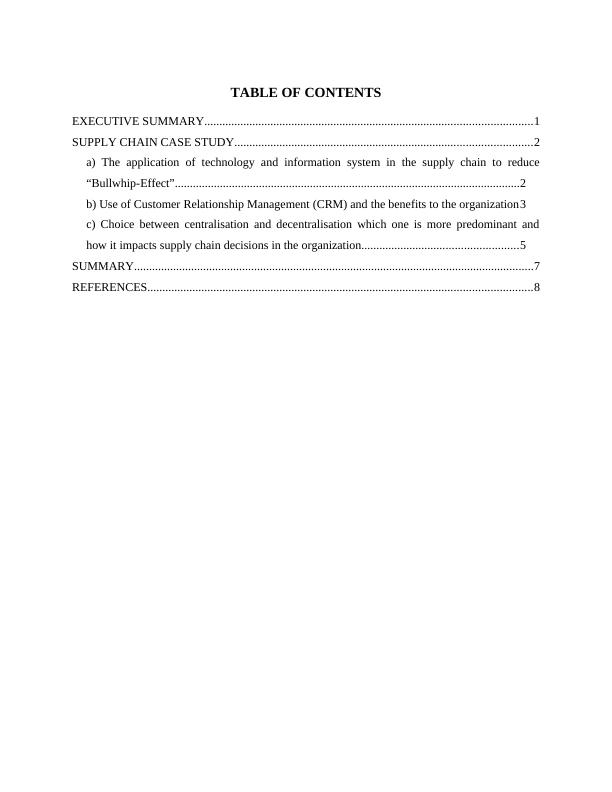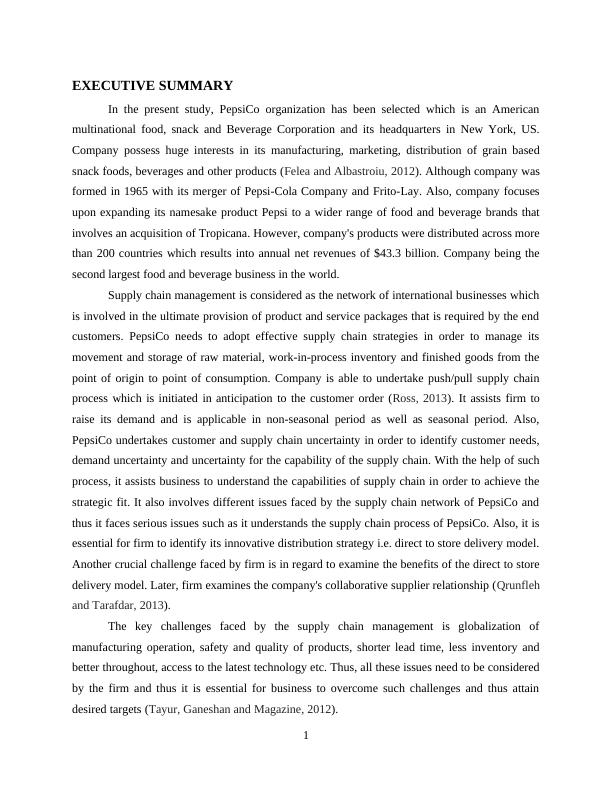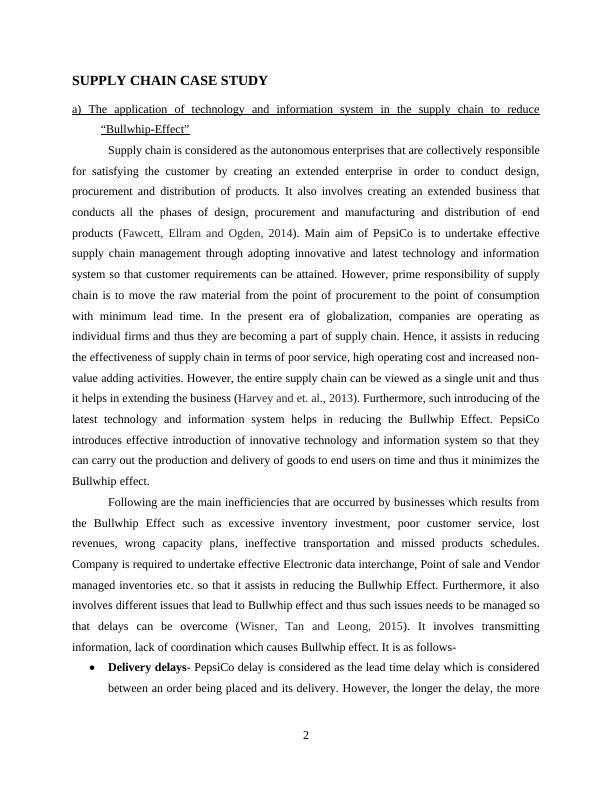Study On PepsiCo - Supply Chain Strategies
11 Pages3412 Words2324 Views
Added on 2020-02-05
Study On PepsiCo - Supply Chain Strategies
Added on 2020-02-05
ShareRelated Documents
TABLE OF CONTENTSEXECUTIVE SUMMARY.............................................................................................................1SUPPLY CHAIN CASE STUDY...................................................................................................2a) The application of technology and information system in the supply chain to reduce“Bullwhip-Effect”...................................................................................................................2b) Use of Customer Relationship Management (CRM) and the benefits to the organization3c) Choice between centralisation and decentralisation which one is more predominant andhow it impacts supply chain decisions in the organization....................................................5SUMMARY.....................................................................................................................................7REFERENCES................................................................................................................................8


EXECUTIVE SUMMARYIn the present study, PepsiCo organization has been selected which is an Americanmultinational food, snack and Beverage Corporation and its headquarters in New York, US.Company possess huge interests in its manufacturing, marketing, distribution of grain basedsnack foods, beverages and other products (Felea and Albastroiu, 2012). Although company wasformed in 1965 with its merger of Pepsi-Cola Company and Frito-Lay. Also, company focusesupon expanding its namesake product Pepsi to a wider range of food and beverage brands thatinvolves an acquisition of Tropicana. However, company's products were distributed across morethan 200 countries which results into annual net revenues of $43.3 billion. Company being thesecond largest food and beverage business in the world. Supply chain management is considered as the network of international businesses whichis involved in the ultimate provision of product and service packages that is required by the endcustomers. PepsiCo needs to adopt effective supply chain strategies in order to manage itsmovement and storage of raw material, work-in-process inventory and finished goods from thepoint of origin to point of consumption. Company is able to undertake push/pull supply chainprocess which is initiated in anticipation to the customer order (Ross, 2013). It assists firm toraise its demand and is applicable in non-seasonal period as well as seasonal period. Also,PepsiCo undertakes customer and supply chain uncertainty in order to identify customer needs,demand uncertainty and uncertainty for the capability of the supply chain. With the help of suchprocess, it assists business to understand the capabilities of supply chain in order to achieve thestrategic fit. It also involves different issues faced by the supply chain network of PepsiCo andthus it faces serious issues such as it understands the supply chain process of PepsiCo. Also, it isessential for firm to identify its innovative distribution strategy i.e. direct to store delivery model.Another crucial challenge faced by firm is in regard to examine the benefits of the direct to storedelivery model. Later, firm examines the company's collaborative supplier relationship (Qrunflehand Tarafdar, 2013). The key challenges faced by the supply chain management is globalization ofmanufacturing operation, safety and quality of products, shorter lead time, less inventory andbetter throughout, access to the latest technology etc. Thus, all these issues need to be consideredby the firm and thus it is essential for business to overcome such challenges and thus attaindesired targets (Tayur, Ganeshan and Magazine, 2012). 1

SUPPLY CHAIN CASE STUDYa) The application of technology and information system in the supply chain to reduce“Bullwhip-Effect”Supply chain is considered as the autonomous enterprises that are collectively responsiblefor satisfying the customer by creating an extended enterprise in order to conduct design,procurement and distribution of products. It also involves creating an extended business thatconducts all the phases of design, procurement and manufacturing and distribution of endproducts (Fawcett, Ellram and Ogden, 2014). Main aim of PepsiCo is to undertake effectivesupply chain management through adopting innovative and latest technology and informationsystem so that customer requirements can be attained. However, prime responsibility of supplychain is to move the raw material from the point of procurement to the point of consumptionwith minimum lead time. In the present era of globalization, companies are operating asindividual firms and thus they are becoming a part of supply chain. Hence, it assists in reducingthe effectiveness of supply chain in terms of poor service, high operating cost and increased non-value adding activities. However, the entire supply chain can be viewed as a single unit and thusit helps in extending the business (Harvey and et. al., 2013). Furthermore, such introducing of thelatest technology and information system helps in reducing the Bullwhip Effect. PepsiCointroduces effective introduction of innovative technology and information system so that theycan carry out the production and delivery of goods to end users on time and thus it minimizes theBullwhip effect.Following are the main inefficiencies that are occurred by businesses which results fromthe Bullwhip Effect such as excessive inventory investment, poor customer service, lostrevenues, wrong capacity plans, ineffective transportation and missed products schedules.Company is required to undertake effective Electronic data interchange, Point of sale and Vendormanaged inventories etc. so that it assists in reducing the Bullwhip Effect. Furthermore, it alsoinvolves different issues that lead to Bullwhip effect and thus such issues needs to be managed sothat delays can be overcome (Wisner, Tan and Leong, 2015). It involves transmittinginformation, lack of coordination which causes Bullwhip effect. It is as follows-Delivery delays- PepsiCo delay is considered as the lead time delay which is consideredbetween an order being placed and its delivery. However, the longer the delay, the more2

End of preview
Want to access all the pages? Upload your documents or become a member.
Related Documents
DIPLOMA TRANSPORTATION AND DISTRIBUTION MANAGEMENT.lg...
|13
|3341
|6
PEM'16 BATCH SECTION 2 ELECTIVE GROUP - 6 PEM'16 BATCH SECTION 2 ELECTIVE GROUP - 6 PEPEPSICOlg...
|16
|3382
|287
Logistics and Supply Chain Management at PepsiColg...
|10
|3034
|369
Logistics and Supply Chain of PepsiColg...
|10
|2620
|107
Operational Function of CEO Report 2022lg...
|17
|3255
|15
Supply Chain Management assignment (pdf)lg...
|11
|2729
|1635
